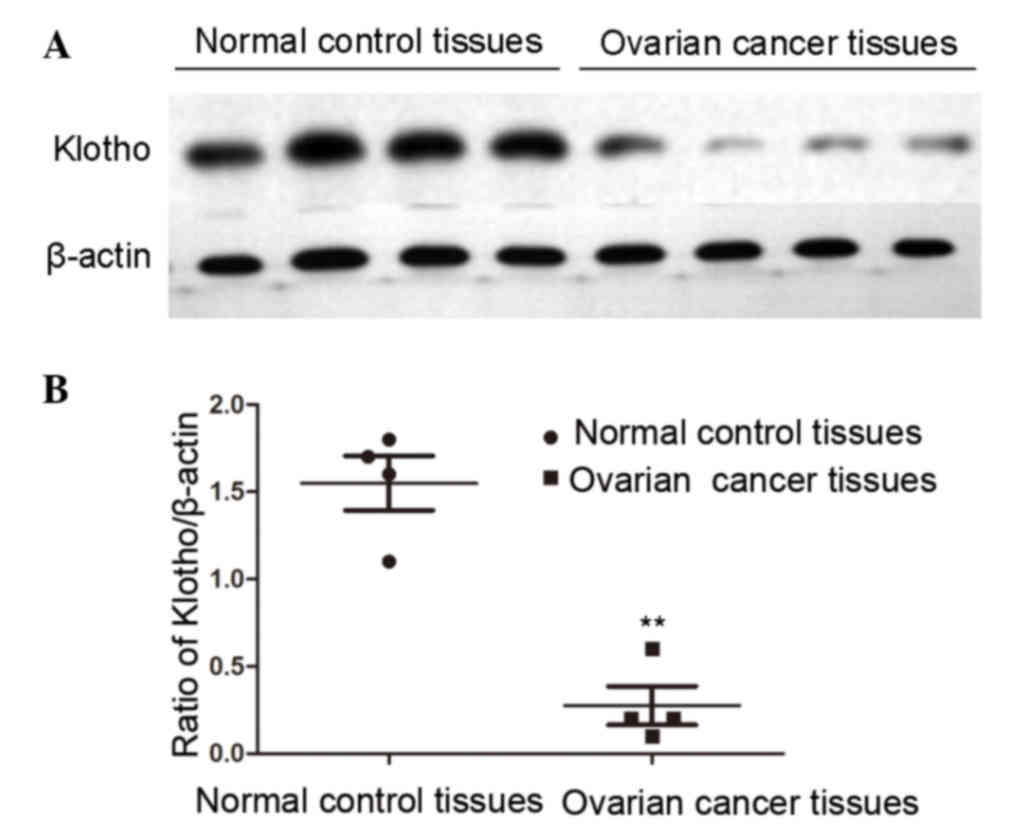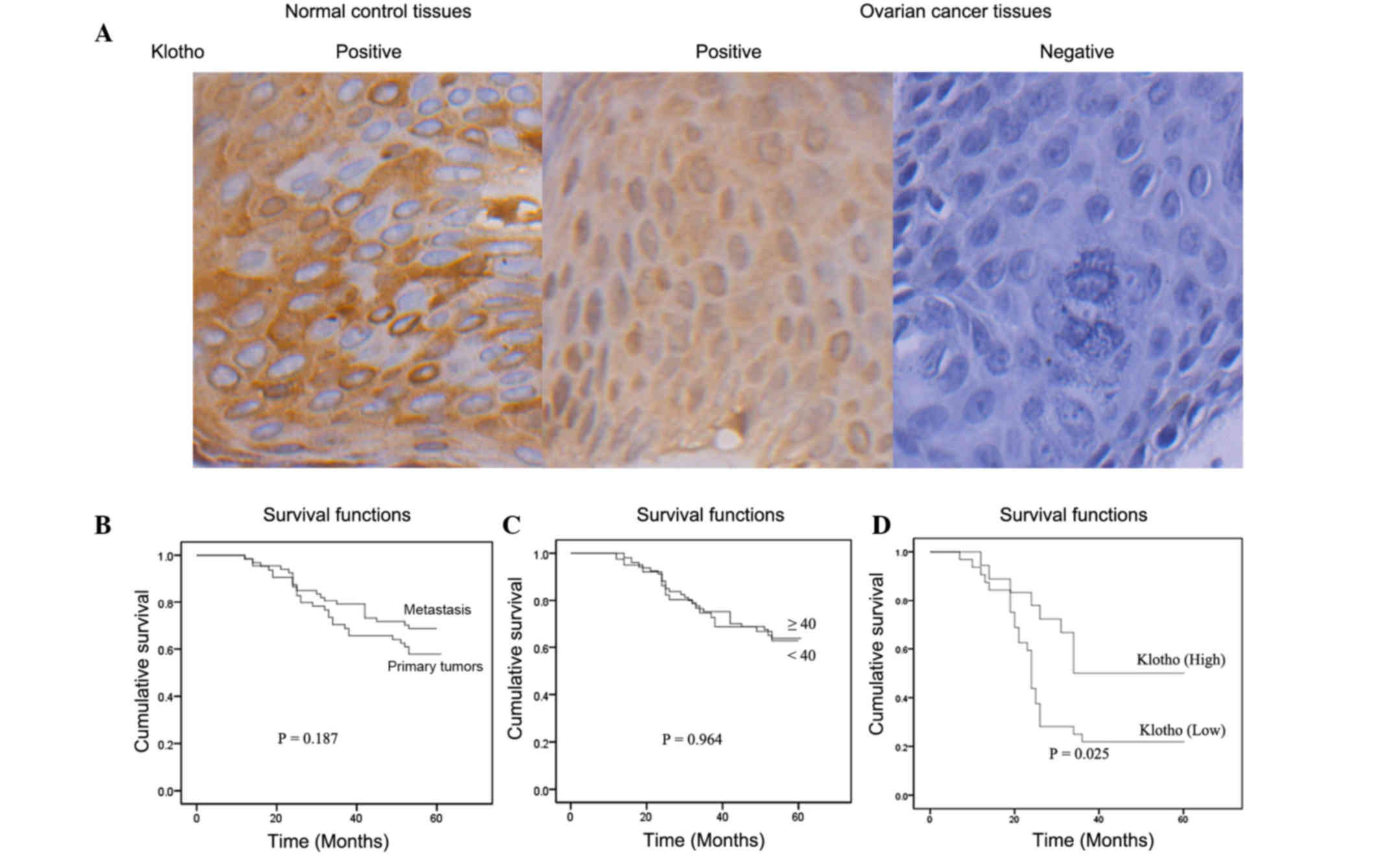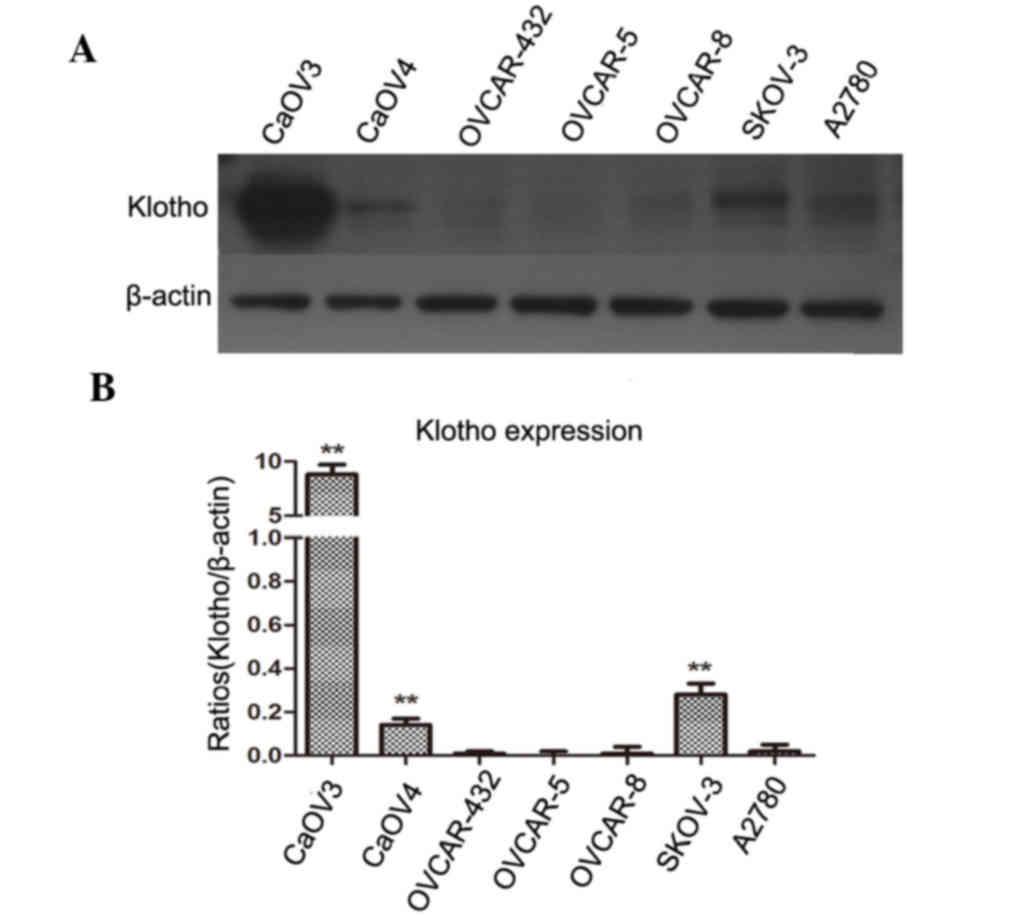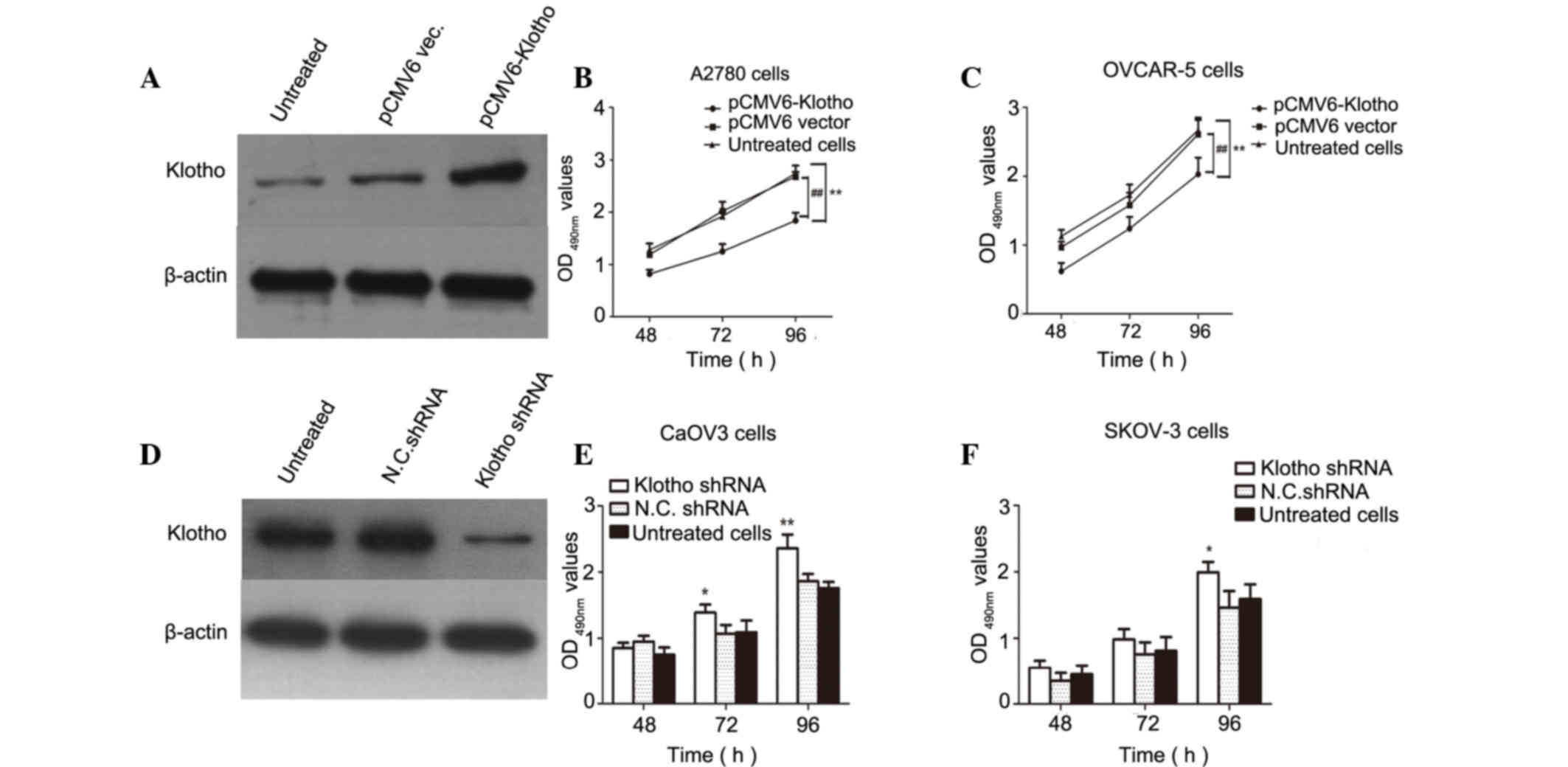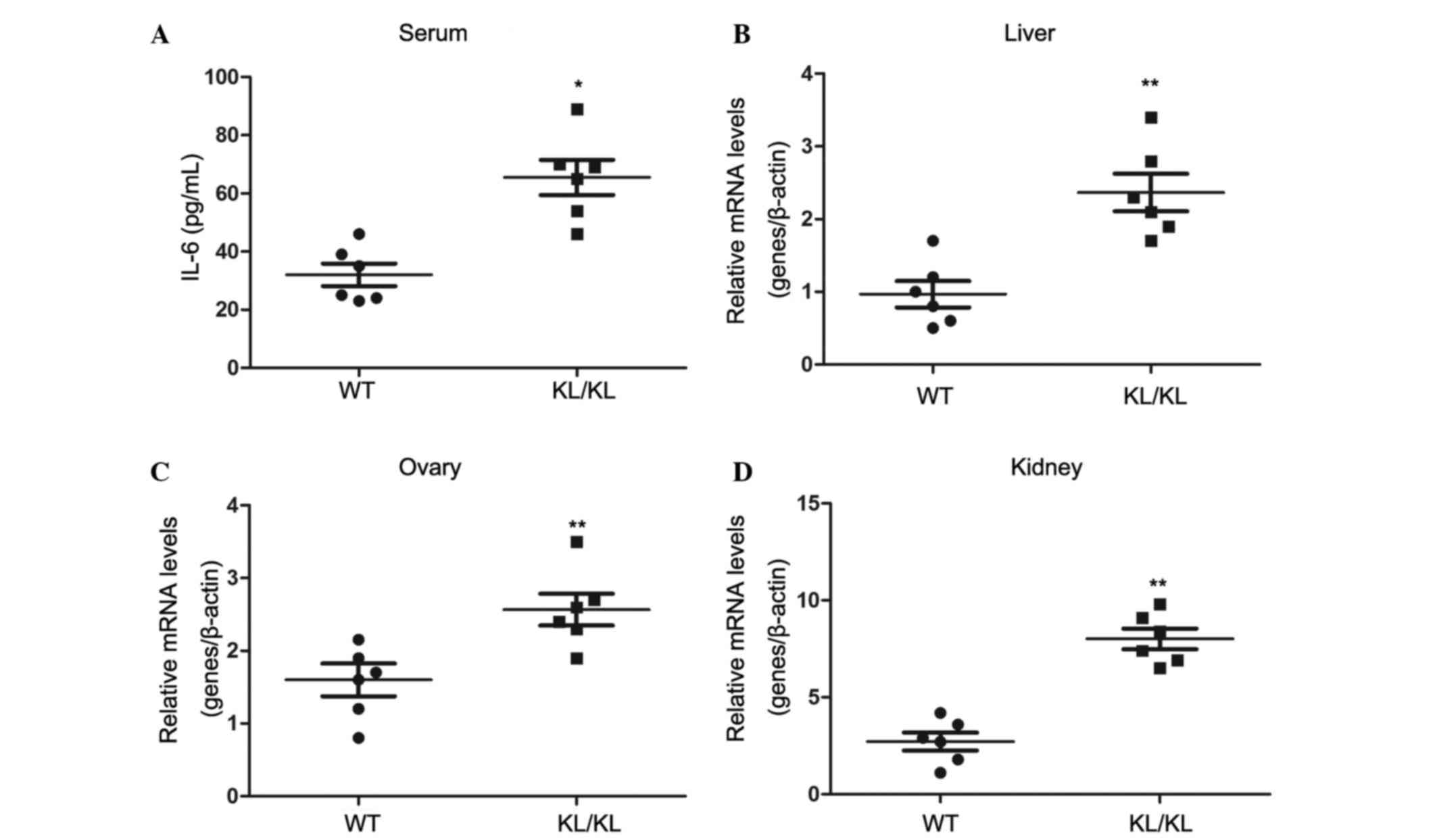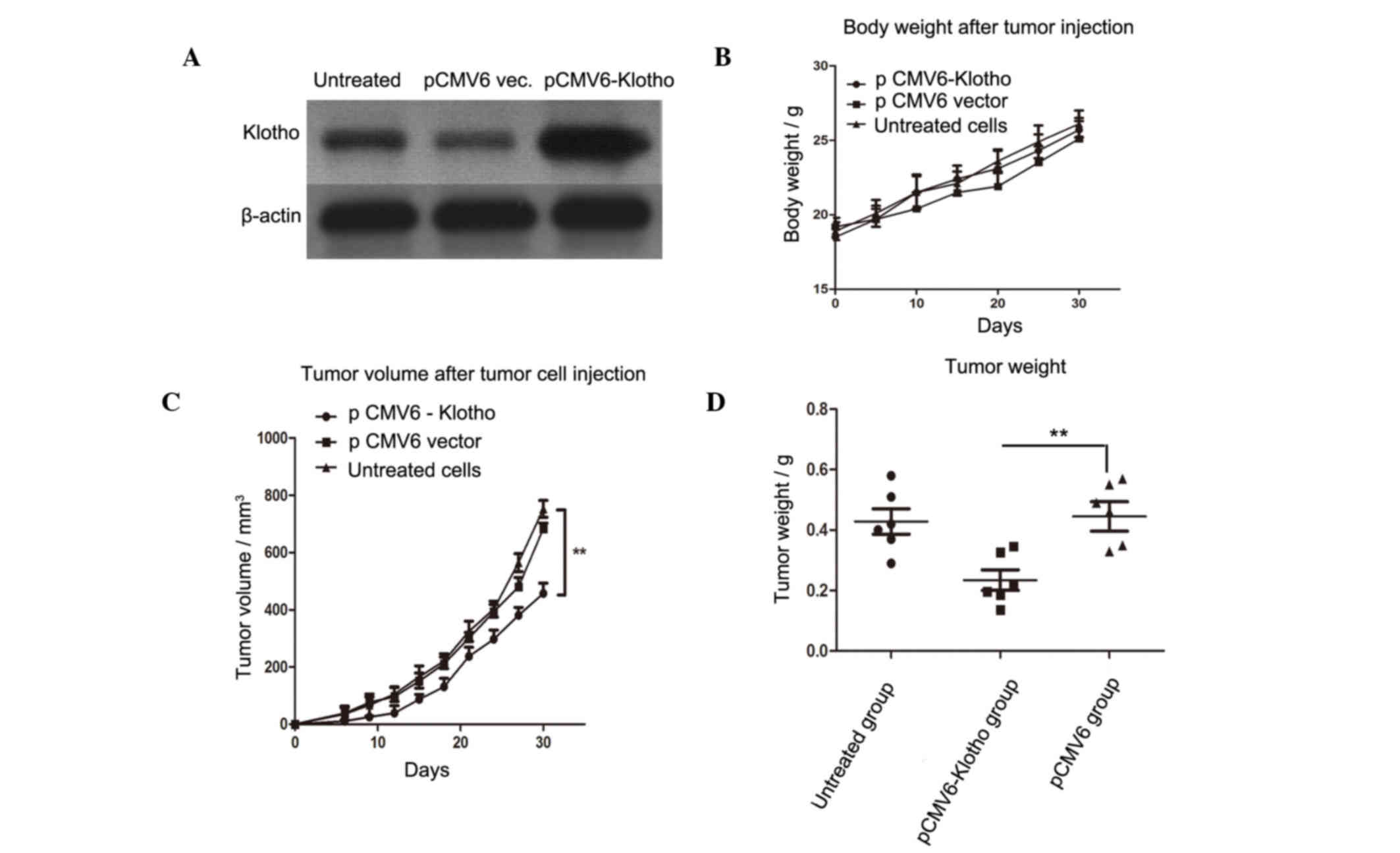Reduced Klotho expression contributes to poor survival rates in human patients with ovarian cancer, and overexpression of Klotho inhibits the progression of ovarian cancer partly via the inhibition of systemic inflammation in nude mice
- Authors:
- Published online on: February 7, 2017 https://doi.org/10.3892/mmr.2017.6172
- Pages: 1777-1785
Abstract
Introduction
Ovarian cancer is a common malignancy of the female reproductive organs (1,2). The incidence of ovarian cancer ranks third, after cervical cancer and uterine body cancer; however, the mortality rate is the highest compared with all other types of gynecological tumor, and it is therefore a serious threat to survival (3–5). In the United States, it was estimated that 22,240 cases of ovarian cancer were newly diagnosed, and an estimated 14,030 cases of mortality were associated with ovarian cancer in 2013 (6,7). The major underlying cause for the high mortality rate is that ~75% of women had metastases throughout the peritoneal cavity and were diagnosed with ovarian cancer at an advanced stage. Although combined chemotherapy may improve the overall survival rate in patients with advanced stage ovarian cancer, novel therapeutic paradigms are required. Furthermore, the underlying molecular mechanism remains to be clearly defined, since the pathology differs in various types of ovarian cancer.
Klotho is a recently discovered anti-aging protein, and Klotho-deficient mice exhibit a premature aging-like syndrome (8). Klotho is predominantly distributed in the kidneys and brain, and has an essential role in protecting against dysfunction of the kidney-brain axis during the aging process (9). There are two types of Klotho protein: Transmembrane and secreted forms of Klotho (10,11). Both of these proteins exert distinct functions, which may collectively affect aging processes in mammals. The single-pass transmembrane protein forms a complex with numerous fibroblast growth factor receptors, whereas secreted Klotho protein regulates the activity of several ion channels and growth factors, including insulin, insulin-like growth factor 1 (IGF-1) and Wnt (12). Klotho has been studied and reported to act as a tumor suppressor in various human malignancies (13–15). Previous studies have focused on the role of Klotho in tumorigenesis, cancer progression and prognosis. Klotho has been reported to exert antitumor effects by inhibiting insulin/IGF1, p53/p21 and Wnt signaling, and silencing Klotho expression was mediated by promoter hypermethylation and histone deacetylation in the progression of tumors (13,16). In addition, Lee et al examined epigenetic silencing of Klotho in human cervical carcinoma, and the functional loss of Klotho as a secreted Wnt antagonist contributed to aberrant activation of the canonical Wnt pathway in cervical carcinoma (17).
To the best of our knowledge, there are currently two main research groups that have reported on the role of Klotho in human ovarian cancer. Lu et al demonstrated that Klotho expression was associated with epithelial ovarian cancer progression and the protein could serve as an independent marker for the prognosis of ovarian cancer (18). Lojkin et al reported that Klotho acted as an inhibitor of the IGF-1 pathway in cancer cells; and restoring its expression slowed the proliferation of epithelial ovarian cancer cells and inhibited transcriptional activity of the estrogen receptor (13). The present study aimed to clarify the association between the expression levels of Klotho in human ovarian cancer tissues and the progression of ovarian cancer. Furthermore, the molecular mechanism underlying the effects of Klotho on ovarian cancer cell lines was explored. The present study provided novel evidence regarding the molecular mechanism underlying human ovarian cancer.
Materials and methods
Patients
Patients were recruited from the Zhujiang Hospital of Southern Medical University (Guangzhou, China). A total of 120 patients with ovarian cancer and 78 normal controls were recruited to the present study. The current study was conducted over a period of 36 months, between March 2012 and March 2015. All patients were diagnosed with ovarian cancer and underwent surgery following their diagnosis. The median age of the patients was 56.8 years (range, 26–82 years). The paired paracancerous tissues were collected as normal controls. The patient was diagnosed with ovarian cancer using a pathological diagnosis. They have not received chemotherapy or irradiation prior to tissue collection. Fresh tumor tissues were collected from each patient during surgery. One fresh tissue sample from each patient was frozen at −80°C for western blotting. Another tissue sample from each patient was fixed in 10% formalin, and paraffin-embedded sections were prepared and cut into 4 µm sections. The research carried out on humans was in compliance with the Helsinki Declaration, and the present study was approved by the Ethics Committee of Zhujiang Hospital of Southern Medical University. The subjects were well informed of the details and signed relevant contracts prior to the study.
Cell lines and reagents
The A2780, SKOV-3, OVCA 432, OVCAR-5 OVCAR-8, CaOV4 and CaOV3 human ovarian cancer cell lines were obtained from the American Type Culture Collection (Manassas, VA, USA). Dulbecco's modified Eagle's medium (DMEM) and fetal bovine serum (FBS) were purchased from Hyclone (GE Healthcare Life Sciences, Logan, UT, USA). Total RNA extraction kit (cat. no. MK700) and cDNA reverse transcription kit (cat. no. 6110) were obtained from Takara Bio, Inc. (Kusatsu, Japan). Lipofectamine 2000 (cat. no. 11668-019) was obtained from Invitrogen (Thermo Fisher Scientific, Inc., Waltham, MA, USA). The stock concentration of short hairpin (sh)RNA was 20 µM and the working concentration was 50 nM. Klotho shRNA Plasmid and control shRNA Plasmid-A were obtained from Santa Cruz Biotechnology Inc. (Dallas, TX, USA). A2780 cells were plated into a 24-well plate at a density of 2×104 cells/well. The cells were grown to 70–80% confluence. Klotho shRNA plasmid (2 µl) or control shRNA plasmid (2 µl) and 5 µl Lipofectamine 2000 were diluted into 100 µl Opti-MEM, respectively. The shRNA were gently mixed and maintained at room temperature for 5 min. Next, the 100 µl of Opti-MEM containing Klotho shRNA and 100 µl Opti-MEM containing lipofectamin 2000 were gently mixed together and kept for 15 min at room temperature. Finally, the mixture was added into the medium of the human ovarian cancer cells to knockdown the Klotho expression levels for indicated time.
Antibodies
Rabbit polyclonal anti-Klotho antibody (cat. no. ab18131) was purchased from Abcam (Cambridge, MA, USA) for use in western blotting. Anti-Klotho antibody (E-21; cat. no. sc-22220) was obtained from Santa Cruz Biotechnology, Inc. for use in immunohistochemistry. Mouse monoclonal anti-β-actin antibody (cat. no. TA310155) was obtained from OriGene Technologies, Inc. (Beijing, China). The secondary antibodies, including goat anti-rabbit immunoglobulin (Ig) G-horseradish peroxidase (HRP) (cat. no. sc-2004) and goat anti-mouse IgG-HRP (cat. no. sc-2005) were obtained from Santa Cruz Biotechnology, Inc.
Immunohistochemical analysis
Immunohistochemical analysis was performed as described previously (19,20). Briefly, paraffin-embedded sections were dewaxed, rehydrated, blocked and incubated overnight at 4°C with the primary antibody specific to Klotho. After three washes with phosphate-buffered saline (PBS), the sections were incubated with secondary antibody for 1 h at room temperature. Subsequently, the slides were dehydrated, mounted in Permount and visualized under a Nikon Eclipse Ti microscope (Nikon Corporation, Tokyo, Japan). Positive and negative images were captured using a camera attached to the microscope at 400x magnification.
Western blot analysis
Frozen cancerous and paracancerous tissues were homogenized using TRIzol reagent (Invitrogen; Thermo Fisher Scientific, Inc.) using the PowerGen 125 homogenizer (Thermo Fisher Scientific, Inc.). The samples were washed with PBS and lysed with radioimmunoprecipitation assay buffer [50 mmol/l Tris, 1% NP-40, 150 mmol/l NaCl, 1 mmol EDTA, 0.1% sodium dodecyl sulfate (SDS), 0.25% SDC]. Whole protein concentrations were quantified using the Bradford assay. Proteins (20 µg per lane) were then separated by 10% SDS-polyacrylamide gel electrophoresis and were transferred electrophoretically to a nitrocellulose membrane at 400 mA for 1 h. The membrane was blocked with 5% non-fat milk in Tris-buffered saline containing Tween (TBST; 50 mmol/l Tris-HCl, 150 mmol/l NaCl and 0.1% Tween). Subsequently, the membranes were incubated with primary antibodies at 4°C overnight and secondary antibodies for 40 min at room temperature. Between incubations the membranes were washed with TBST for 5 min. The bands were detected using an enhanced chemiluminescence western blotting detection system, according to the manufacturer's protocol. β-actin was used as an internal reference. The bands were developed by ECL chemiluminescence kit and visualized by gel imaging system (Bio-Rad Laboratories, Inc., Hercules, CA, USA). Image J version 1.49 (National Institutes of Health- Bethesda, MD, USA) was used to analyze the results form western blotting.
3-(4,5-dimethylthiazol-2-yl)-2,5-diphenyltetrazolium bromide (MTT) assay
The cells were cultured in DMEM, supplemented with 10% FBS, 37°C in 5% CO2 atmosphere. An MTT assay was performed as described previously (21,22). Briefly, the human ovarian cancer cell lines were transfected with pCMV6-Klotho or pCMV6 vector (both obtained from OriGene Technologies, Inc.) for 48, 72 and 96 h. The cancer cells (1×105 cells/well) were seeded into a 48-well plate. The cells were grown to 70–80% confluence. The vector (100 ng) and 5 µl Lipofectamine 2000 were diluted into 100 µl of Opti-MEM which were maintained for 5 min at room temperature. They were mixed gently for 15 min. The mixture was added into the medium of human ovarian cancer cells and cultured for the aforementioned times. Cell proliferation in each group was detected by MTT assay.
Enzyme-linked immunosorbent assay (ELISA)
Whole blood samples (0.2 ml) were obtained from the tail veins of the mice and were maintained at room temperature for 2 h, and the supernatant was obtained following centrifugation at 1,000 × g for 20 min at room temperature. The concentration of inflammatory cytokines was determined using human IL-6 and IL-1β ELISA kits (NeoBioscience, Beijing, China) according to the manufacturer's protocols. Absorbance was measured at 450 nm using a Benchmark Microplate Reader (Bio-Rad Laboratories, Inc., Hercules, CA). All of the samples were analyzed in duplicate for cytokine levels. The concentrations of interleukin (IL)-6 and IL-1β in the samples were determined from standard curves.
Reverse transcription-polymerase chain reaction
Total RNA was isolated from the tissues or cultured cells using TRIzol RNA regent (Tiangen Biotech Co., Ltd., Beijing, China). RNA (1 µg) was reverse transcribed by reverse transcriptase SuperScript III (Invitrogen; Thermo Fisher Scientific, Inc.). The primer sequence of Klotho was sense 5′-ACCTGGTGGCGCACAACC-3′ and antisense 5′-TTGGCAAACCAACCTAGTACA-3′. The PCR reaction conditions were as follows: 94°C for 5 min, followed by 30 cycles of 94°C for 30 sec, 55°C for 30 sec and 72°C for 30 sec and finally, elongation at 72°C for 10 min.
Animals
Male C57BL/6 mice (n=18; weight, 18–20 g; age, 6–8 weeks) were obtained from the Laboratory Animal Center of Peking University Health Science Center (Beijing, China) and were maintained in the specific pathogen-free conditions. The temperature was controlled at 18–22°C, humidity of 50- 60%. Food and water was provided ad libitum. The light:dark cycle was 12:12 h. The mice were challenged subcutaneously with 4×104 A2780 cells in the flank area; each group contained six mice. For the in vivo antitumor experiment, the mice were randomly divided into three groups: i) Klotho group; ii) control plamid group and iii) negative control group. Klotho−/− mice (n=18; weight, 18–20 g; age, 8 weeks) were obtained from CasGene Biotech Co., Ltd. (Beijing, China) and housed in specific pathogen-free conditions. The temperature was controlled at 18–22°C, humidity of 50- 60%. Food and water was provided ad libitum. The light:dark cycle was 12:12 h. Wild type mice with the same genetic background were used as a negative control. After 2 weeks, cytokine levels in the serum were detected by ELISA. The animals used in the present study received humane care in compliance with the Guide to the Care and Use of Experimental Animals formulated by the Medical Ethical Committee on animal experiments of Zhujiang Hospital of Southern Medical University. The mice were sacrificed by cervical after 1 month of tumor injections. The mice were disinfected with 75% alcohol. The tumors in nude mice were weighed and compared between the different groups.
Statistical analysis
Statistical analysis was performed using SPSS 20.0 software (IBM SPSS, Armonk, NY, USA). data are presented as the mean ± standard deviation. Comparisons between Klotho expression levels and clinical indicators were performed by χ2 test. Analysis of variance (ANOVA), followed by a post-hoc test was used for the comparison of multiple groups. A repeated measures ANOVA was used to compare tumor size in mice over time. Kaplan-Meier survival estimates were used to evaluate survival rate. P<0.05 was considered to indicate a statistically significant difference.
Results
Expression levels of Klotho in human ovarian cancer tissues and normal ovarian tissues
In order to identify the role of Klotho in the progression of human ovarian cancer, the expression levels of Klotho were detected by western blotting in patients with human ovarian cancer and normal controls. A total of 120 ovarian cancer specimens and 78 normal ovarian specimens were collected from the hospital; the median age of the patients was 56.8 years (range, 26–86 years). It was essential to use an appropriate internal reference in the experiment; therefore, β-actin was used as the internal reference, since this housekeeping gene exhibits stable expression in various types of cells and tissues. The data were normalized to β-actin and are presented as the mean ± standard deviation. As presented in Fig. 1, the expression levels of Klotho were significantly decreased in human patients with ovarian cancer compared with in the normal control group (P<0.01).
Survival rate is positively correlated with Klotho levels in patients with ovarian cancer
As shown in Fig. 2A, formalin-fixed, paraffin-embedded tissues from 120 patients with ovarian cancer and 78 normal controls were analyzed by immunohistochemistry to detect the protein expression of Klotho. The results indicated that positive Klotho expression was detected in all normal ovarian specimens; however, in human ovarian cancer patients, the positive rate of Klotho was 61.6%, which was significantly decreased compared with in the normal control group (Table I).
In order to clarify the relevance of clinical parameters in the prognosis of human ovarian cancer, the relationship between clinical indicators, including age, metastasis and Klotho expression, and the 5-year survival rates of patients with ovarian cancer was determined. As shown in Fig. 2B, Kaplan-Meier curves demonstrated the survival rate was higher in patients with primary tumors compared with those with metastasis; however, there was no statistical difference (P=0.187). Kaplan-Meier curves were also generated to compare the survival rates of patients that were <40 years old with those that were ≥40 years old; the results demonstrated that there was no statistically significant difference between the two groups (P=0.964; Fig. 2C). In addition, reduced Klotho expression was significantly correlated with decreased survival rates in patients with ovarian cancer (P=0.025; Fig. 2D). These results indicated that Klotho expression was associated with a higher survival probability in patients with human ovarian cancer.
Klotho expression levels in ovarian cancer cell lines
The expression levels of Klotho were detected in several human ovarian cancer cell lines by western blotting. As shown in Fig. 3, Klotho protein was not expressed or was expressed at low levels in four cell lines: OVCA 432, OVCAR-5, OVCAR-8 and A2780. Low expression levels were observed in two cell lines: CaOV4 and SKOV-3. Notably, the CaOV3 human ovarian cancer cell line expressed high levels of Klotho compared with in the ovarian cancer cell lines where no Klotho was detected (P<0.01).
High levels of Klotho inhibit the proliferation of human ovarian cancer cells
In order to clarify the relationship between Klotho expression and the proliferation of ovarian cancer cells, two human ovarian cancer cell lines were selected as a cell model. A2780 cells exhibited hardly any detectable Klotho expression, and CaOV3 cells exhibited high Klotho levels. In Fig. 4A, Klotho was overexpressed in A2780 cells and the results demonstrated that Klotho levels were markedly increased compared with in the negative control cells. Subsequently, proliferative activity was determined by MTzT assay in pCMV6-Klotho and pCMV6 vector-transfected ovarian cancer cells. The data revealed that overexpression of Klotho in A2780 and OVCAR-5 cells contributed to the inhibition of human ovarian cancer cell proliferation compared with in untreated and pCMV6 vector-transfected cells (P<0.01; Fig. 4B and C). In addition, endogenous Klotho expression was suppressed by Klotho-specific shRNA. As expected, Klotho expression was suppressed in CaOV3 cells transfected with the shRNA, as detected by western blotting. Results of the MTT assay demonstrated that Klotho shRNA-transfected optical density (490 nm) values were increased compared with negative control shRNA-transfected cells or untreated cells (P<0.05 and P<0.01, compared with untreated cells; Fig. 4D-F). These data indicated that high levels of Klotho inhibited the proliferation of human ovarian cancer cells, and inhibiting the endogenous expression of Klotho may promote tumor cell growth in human ovarian cancer cells.
Plasma IL-6 and IL-1β levels are elevated in tumor-bearing mice
In order to detect the inflammatory responses in normal and tumor-bearing mice, inflammatory cytokine levels in the plasma were detected. The concentrations of plasma IL-6 and IL-1β were detected by ELISA. As shown in Fig. 5, mean plasma IL-6 concentration was 63.0 pg/ml in tumor-bearing mice, which was significantly increased compared with in the wild type mice (39.9 pg/ml; P<0.01). The levels of IL-1β showed a similar trend to IL-6. The concentration of IL-1β in the plasma of tumor-bearing mice was 46.43 pg/ml, which was significantly increased compared with the mean value in wild type mice (25.0 pg/ml; P<0.01). These results indicated that plasma IL-6 and IL-1β levels are elevated in tumor-bearing mice, thus suggesting that the systemic inflammatory response was severe in tumor-bearing mice.
Aberrant Klotho expression contributes to systemic chronic inflammation in Klotho−/− mice
In order to determine whether aberrant Klotho expression would induce or suppress systemic inflammation in mice, 8-week-old Klotho−/− mice and wild type mice with the same genetic background were used as an animal model. As presented in Fig. 6A, plasma IL-6 levels in Klotho−/− mice were 65.0 pg/ml, whereas plasma IL-6 concentration was 32.0 pg/ml in the wild type mice with the same genetic background (P<0.05).
The mRNA expression levels of IL-6 were detected in various organs, including the liver, ovaries and kidneys (Fig. 6B-D). The results demonstrated that the expression levels of IL-6 were significantly elevated in the liver, ovaries and kidneys of the Klotho−/− mice compared with in the wild type mice (P<0.01). These data demonstrated that aberrant Klotho expression may contribute to systemic inflammation in Klotho−/− mice.
Overexpression of Klotho suppresses tumor growth in a murine model
To assess the in vivo antitumor role of aberrant Klotho expression, A2780 human ovarian cancer cells were transfected with pCMV6-Klotho, and the stably transfected cells were screened. As shown in Fig. 7A, the expression of Klotho was markedly elevated in pCMV6-Klotho-transfected A2780 cells compared with in the PCMV6 vector-transfected cells or untreated cells. Mice were randomly divided into three groups (n=6/group). The mice were subcutaneously challenged with 3×105 live stably transfected A2780 cells in the rear leg flank. A total of 10 days after the injection, tumors became gradually evident. The mice in each group were observed daily to monitor tumor volume. A total of 30 days after tumor injection, the mice were sacrificed and tumor weight was determined in each group. There was no significant difference in body weight between the three groups (Fig. 7B); however, tumor volume and tumor weight were significantly decreased in the PCMV6-Klotho group compared with in the pCMV6 vector group (P<0.01).
Discussion
Ovarian cancer is a common malignancy that affects the ovaries (23–25). Previous studies have demonstrated that Klotho is involved in the development and progression of several types of human tumor (26,27); however, the effects of Klotho on ovarian cancer have not been clearly reported. The present study explored the role of Klotho in the progression of ovarian cancer, and investigated the molecular mechanism underlying the effects of Klotho during the progression of human ovarian tumors.
The present study detected Klotho expression in 120 ovarian cancer specimens and 78 normal ovarian specimens by western blotting and immunohistochemical analysis. The results demonstrated that Klotho acted as a tumor suppressor in human ovarian cancer. Notably, Klotho was highly expressed in normal control specimens; however, its expression was significantly reduced in 38.4% of specimens with ovarian cancers. Furthermore, reduced levels of Klotho were correlated with lower survival rates in patients with ovarian cancer (P=0.025). In addition, survival rate was not associated with age or metastasis. These results indicated that Klotho may serve as an indicator for the prognosis of patients with ovarian cancer.
The expression levels of Klotho were detected in seven human ovarian cancer cell lines by western blotting. Notably, CaOV3 cells were shown to have the highest levels of Klotho, CaOV4 and SKOV-3 cells had medium levels of Klotho protein, and four ovarian cancer cell lines, OVCA 432, OVCAR-5, OVCAR-8 and A2780, had almost no detectable levels of Klotho. Therefore, the ovarian cell lines with the highest and the lowest expression of Klotho served as a cell model. The results of an MTT assay demonstrated that overexpression of Klotho inhibited the proliferation of ovarian cancer cells, whereas suppression of Klotho promoted the growth of CaOV3 cells. These data suggested that Klotho may act as a tumor suppressor in human ovarian cancer cells.
An in vivo experiment in Klotho−/− mice demonstrated that IL-6 plasma concentration was significantly increased in Klotho−/− mice compared with in wild type mice with the same genetic background. This result was consistent with the mRNA expression levels of IL-6 detected in the liver, ovaries and kidneys of Klotho−/− mice. These data suggested that aberrant Klotho expression contributed to systemic inflammation. Notably, overexpression of Klotho suppressed tumor growth and tumor volume in a murine model, which was partly due to the inhibition of systemic inflammation and other tumor growth-related signaling pathways, such as Akt, ERK, insulin and Wnt signaling pathways.
In conclusion, the present study determined that aberrant Klotho expression contributed to systemic inflammation. Overexpression of Klotho suppressed tumor growth and tumor volume in a murine model, which was partly due to the inhibition of systemic inflammation.
References
|
Yahata T, Banzai C and Tanaka K: Niigata Gynecological Cancer Registry: Histology-specific long-term trends in the incidence of ovarian cancer and borderline tumor in Japanese females: A population-based study from 1983 to 2007 in Niigata. J Obstet Gynaecol Res. 38:645–650. 2012. View Article : Google Scholar : PubMed/NCBI | |
|
Maksimović M, Maksimović M, Gojnić M, Maksimović Z, Petković S, Ljubić A, Stefanović A and Jeremić K: Surgical treatment of ovarian cancer and early detection of venous thromboembolism. Eur J Gynaecol Oncol. 32:415–418. 2011.PubMed/NCBI | |
|
Chen M, Jin Y, Bi Y, Li Y, Shan Y and Pan L: Prognostic significance of lymphovascular space invasion in epithelial ovarian cancer. J Cancer. 6:412–419. 2015. View Article : Google Scholar : PubMed/NCBI | |
|
Lloyd KL, Cree IA and Savage RS: Prediction of resistance to chemotherapy in ovarian cancer: A systematic review. BMC Cancer. 15:1172015. View Article : Google Scholar : PubMed/NCBI | |
|
Bacalbaşa N and Popescu I: Ovarian cancer liver metastases - should we apply the principle of optimal cytoreduction to the liver? A review. Hepatogastroenterology. 62:355–357. 2015.PubMed/NCBI | |
|
Rooth C: Ovarian cancer: Risk factors, treatment and management. Br J Nurs. 22:S23–S30. 2013. View Article : Google Scholar : PubMed/NCBI | |
|
Liu XH, Man YN and Wu XZ: Recurrence season impacts the survival of epithelial ovarian cancer patients. Asian Pac J Cancer Prev. 15:1627–1632. 2014. View Article : Google Scholar : PubMed/NCBI | |
|
Dërmaku-Sopjani M, Kolgeci S, Abazi S and Sopjani M: Significance of the anti-aging protein Klotho. Mol Membr Biol. 30:369–385. 2013. View Article : Google Scholar : PubMed/NCBI | |
|
Zeng Y, Wang PH, Zhang M and Du JR: Aging-related renal injury and inflammation are associated with downregulation of Klotho and induction of RIG-I/NF-κB signaling pathway in senescence-accelerated mice. Aging Clin Exp Res. 28:69–76. 2016. View Article : Google Scholar : PubMed/NCBI | |
|
Banerjee S, Zhao Y, Sarkar PS, Rosenblatt KP, Tilton RG and Choudhary S: Klotho ameliorates chemically induced endoplasmic reticulum (ER) stress signaling. Cell Physiol Biochem. 31:659–672. 2013. View Article : Google Scholar : PubMed/NCBI | |
|
Huang CL: Regulation of ion channels by secreted Klotho. Adv Exp Med Biol. 728:100–106. 2012. View Article : Google Scholar : PubMed/NCBI | |
|
Kuro-o M: Klotho and aging. Biochim Biophys Acta. 1790:1049–1058. 2009. View Article : Google Scholar : PubMed/NCBI | |
|
Lojkin I, Rubinek T, Orsulic S, Schwarzmann O, Karlan BY, Bose S and Wolf I: Reduced expression and growth inhibitory activity of the aging suppressor klotho in epithelial ovarian cancer. Cancer Lett. 362:149–157. 2015. View Article : Google Scholar : PubMed/NCBI | |
|
Wolf I, Levanon-Cohen S, Bose S, Ligumsky H, Sredni B, Kanety H, Kuro-o M, Karlan B, Kaufman B, Koeffler HP and Rubinek T: Klotho: A tumor suppressor and a modulator of the IGF-1 and FGF pathways in human breast cancer. Oncogene. 27:7094–7105. 2008. View Article : Google Scholar : PubMed/NCBI | |
|
Zhou X and Wang X: Klotho: A novel biomarker for cancer. J Cancer Res Clin Oncol. 141:961–969. 2015. View Article : Google Scholar : PubMed/NCBI | |
|
Xie B, Chen J, Liu B and Zhan J: Klotho acts as a tumor suppressor in cancers. Pathol Oncol Res. 19:611–617. 2013. View Article : Google Scholar : PubMed/NCBI | |
|
Lee J, Jeong DJ, Kim J, Lee S, Park JH, Chang B, Jung SI, Yi L, Han Y, Yang Y, et al: The anti-aging gene KLOTHO is a novel target for epigenetic silencing in human cervical carcinoma. Mol Cancer. 9:1092010. View Article : Google Scholar : PubMed/NCBI | |
|
Lu L, Katsaros D, Wiley A, de la Longrais IA, Puopolo M and Yu H: Klotho expression in epithelial ovarian cancer and its association with insulin-like growth factors and disease progression. Cancer Invest. 26:185–192. 2008. View Article : Google Scholar : PubMed/NCBI | |
|
Saleem M, Maddodi N, Abu Zaid M, Khan N, bin Hafeez B, Asim M, Suh Y, Yun JM, Setaluri V and Mukhtar H: Lupeol inhibits growth of highly aggressive human metastatic melanoma cells in vitro and in vivo by inducing apoptosis. Clin Cancer Res. 14:2119–2127. 2008. View Article : Google Scholar : PubMed/NCBI | |
|
Adhami VM, Siddiqui IA, Ahmad N, Gupta S and Mukhtar H: Oral consumption of green tea polyphenols inhibits insulin-like growth factor-I-induced signaling in an autochthonous mouse model of prostate cancer. Cancer Res. 64:8715–8722. 2004. View Article : Google Scholar : PubMed/NCBI | |
|
Spinner DM: MTT growth assays in ovarian cancer. Methods Mol Med. 39:175–177. 2001.PubMed/NCBI | |
|
Sargent J, Elgie A, Taylor CG, Wilson J, Alton P and Hill JG: The identification of drug resistance in ovarian cancer and breast cancer: Application of the MTT assay. Contrib Gynecol Obstet. 19:64–75. 1994.PubMed/NCBI | |
|
Ebell MH, Culp M, Lastinger K and Dasigi T: A systematic review of the bimanual examination as a test for ovarian cancer. Am J Prev Med. 48:350–356. 2015. View Article : Google Scholar : PubMed/NCBI | |
|
Ozga M, Aghajanian C, Myers-Virtue S, McDonnell G, Jhanwar S, Hichenberg S and Sulimanoff I: A systematic review of ovarian cancer and fear of recurrence. Palliat Support Care. 13:1771–1780. 2015. View Article : Google Scholar : PubMed/NCBI | |
|
Iżycka N, Lubin J, Markowska A and Markowska J: Late recurrence of ovarian cancer: A literature review and description of two cases. Eur J Gynaecol Oncol. 36:351–353. 2015.PubMed/NCBI | |
|
Martín-Núñez E, Donate-Correa J, Muros-de-Fuentes M, Mora-Fernández C and Navarro-González JF: Implications of Klotho in vascular health and disease. World J Cardiol. 6:1262–1269. 2014. View Article : Google Scholar : PubMed/NCBI | |
|
Wang Y, Chen L, Huang G, He D, He J, Xu W, Zou C, Zong F, Li Y, Chen B, et al: Klotho sensitizes human lung cancer cell line to cisplatin via PI3k/Akt pathway. PloS One. 8:e573912013. View Article : Google Scholar : PubMed/NCBI |



